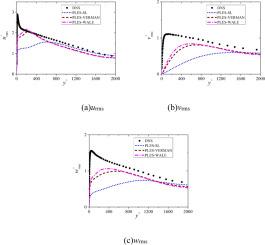Study on effects of subgrid-scale eddy-viscosity model on production-limited eddy simulation
IF 6.3
3区 工程技术
Q1 ENGINEERING, CHEMICAL
Journal of the Taiwan Institute of Chemical Engineers
Pub Date : 2025-07-24
DOI:10.1016/j.jtice.2025.106310
引用次数: 0
Abstract
Background
SGS models have significant impact on the LES prediction. However, the influence of subgrid-scale (SGS) eddy-viscosity models on the predictive performance of the Production-limited Eddy Simulation (PLES) for handling various complex turbulent flows is unknown. This study underscores the importance of SGS eddy-viscosity models in shaping the performance of the PLES model.
Methods
Numerical simulations are conducted to investigate the effect of subgrid-scale (SGS) eddy-viscosity models on the performance of PLES, comparing three commonly used SGS models: Smagorinsky-Lilly (SL), Vreman (VREMAN), and Wall-Adapting Local Eddy-viscosity (WALE).
Significant Findings
In the fully developed turbulent channel flow, all models effectively address the log-layer mismatch issue. The PLES-SL model predicts the highest turbulent viscosity, leading to a larger RANS (Reynolds-averaged Navier-Stokes) region, fewer resolved vortex structures, and lower RMS (root-mean-square) velocity near the wall. The PLES-VREMAN and PLES-WALE models yield similar turbulent viscosities, RANS regions, velocity profiles, and RMS velocities. The PLES-SL model shows greater sensitivity to grid resolution, while the others exhibit less dependence on grid refinement. For the flow around a cylinder, the PLES-SL model predicts a smaller recirculation zone and exhibits stronger vortex street fluctuations due to its higher turbulent viscosity. The PLES-VREMAN model performs best in predicting the time-averaged physical quantities and Reynolds stress.

亚网格尺度涡粘模型对限产涡模拟的影响研究
dsgs模式对LES预测有显著影响。然而,亚网格尺度(SGS)涡流粘度模型对限产涡模拟(PLES)处理各种复杂湍流预测性能的影响尚不清楚。这一研究强调了SGS涡流黏度模型在塑造涡流黏度模型性能方面的重要性。方法通过数值模拟研究了亚网格尺度(SGS)涡流黏度模型对多目标耦合性能的影响,比较了Smagorinsky-Lilly (SL)、Vreman (Vreman)和wall - adaptive Local eddy-viscosity (WALE)三种常用的SGS模型。在充分发展的湍流河道中,所有模型都有效地解决了日志层失配问题。PLES-SL模型预测了最高的湍流粘度,导致更大的RANS (reynolds -average Navier-Stokes)区域,更少的分解涡结构和更低的RMS(均方根)速度靠近壁面。PLES-VREMAN和PLES-WALE模型产生相似的湍流粘度、RANS区域、速度分布和RMS速度。pls - sl模型对网格分辨率表现出更高的敏感性,而其他模型对网格细化的依赖性较小。对于圆柱绕流,由于其较高的湍流粘度,pls - sl模型预测了较小的再循环区,并表现出更强的涡街波动。pls - vreman模型在预测时间平均物理量和雷诺应力方面表现最好。
本文章由计算机程序翻译,如有差异,请以英文原文为准。
求助全文
约1分钟内获得全文
求助全文
来源期刊
CiteScore
9.10
自引率
14.00%
发文量
362
审稿时长
35 days
期刊介绍:
Journal of the Taiwan Institute of Chemical Engineers (formerly known as Journal of the Chinese Institute of Chemical Engineers) publishes original works, from fundamental principles to practical applications, in the broad field of chemical engineering with special focus on three aspects: Chemical and Biomolecular Science and Technology, Energy and Environmental Science and Technology, and Materials Science and Technology. Authors should choose for their manuscript an appropriate aspect section and a few related classifications when submitting to the journal online.

 求助内容:
求助内容: 应助结果提醒方式:
应助结果提醒方式:


